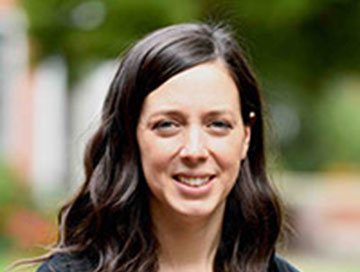
Kathryn Lee
Kathryn Lee Visiting Assistant Professor

Murdock 122
Education
- B.A. in biology with a minor in chemistry from Carroll College
- Ph.D. in cell and developmental biology from Oregon Health and Science University
Research interests
I am not currently directing research at Linfield, but my past research has been focused on transcriptional control and multidrug resistance in cancer.
In my graduate work at Oregon Health and Science University I focused on understanding the regulation and functions of the tumor suppressor ASPP and the characterization of an ASPP2 relative called ΔN-ASPP2 as a potential oncogene.
As a postdoctoral fellow at the Knight Cancer Institute, I worked to understand how prostate cancer develops resistance to first- and second-line therapies and the mechanisms that underlie progression to the lethal form of the disease. My projects in the lab focused mainly on elucidating the signaling pathways that allow advanced prostate cancer to become resistant to anti-androgen enzalutamide therapy.
Academic interests
I primarily teach Introductory Principles of Biology (POB) series (courses BIOL 210 and BIOL 211) here at Linfield and I love working with biology majors and non-majors on this foundational material. I specifically love teaching the introductory Linfield curriculum because of the unique evolutionary lens that we use to explore why and how the biological world works at all levels.
My students often tease me because I frequently get very animated with my arms waving excitedly about many POB topics. I love passing my enthusiasm on to my students whenever I can.
As a result of both my love of biology and my years of teaching experience in the undergraduate classroom, I have developed three main goals as an educator:
- To teach students ownership of and engagement in the educational process
- To ensure a classroom that is accessible for all students
- And lastly, to make sure that everyone gets their arms waving a little
Publications
- King C, Woodward J, Schwarzman J, Coleman D, Lisac R, Wang N, Van Hook K, Gao L, Urrutia J, Dane M, Heiser L, and Alumkal J. 2017. “Integrative molecular network analysis identifies emergent enzalutamide resistance mechanisms in prostate cancer.” Oncotoarget. 8(67): 111084-111095.
- Van Hook K, Wang Z, Chen D, Nold C, Zhu Z, Anur P, Lee HJ, Yu Z, Sheppard B, Dai MS, Sears R, Spellman P, and Lopez CD. 2017. “ΔN-ASPP2 is a novel isoform of the ASPP2 tumor suppressor and a regulator of p53 function.” Biochemical and Biophysical Research Communications, 482(4): 1271-1277.
- Coleman DJ, Van Hook K, King CJ, Schwartzman J, Lisac J, Urrutia J, Sehrawat A, Woodward J, Wang NJ, Gulati R, Thomas GV, Beer TM, Gleave M, Korkola JE, Gao L, Heiser LM, Alumkal J. 2016. "Cellular androgen content influences enzalutamide agonism of F876L-mutant androgen receptor." Oncotarget. 7(26): 40690-40703.
- Van Hook K, Huang T, Alumkal J. 2014. “Orteronel for the treatment of prostate cancer.” Future Oncology. 10(5): 803-811.
- Wang Z, Liu Y, Takahashi M, Van Hook K, Kampa-Schittenhelm KM, Sheppard BC, Sears RC, Stork PJ, Lopez CD. 2012. “The N-terminus of the ASPP2 tumor suppressor binds to Ras and enhances Ras/Raf/MEK/ERK activation to promote oncogene-induced cellular senescence.” Proceedings of the National Academy of Sciences. 110(1): 312-317.
- Van Hook K, Wang P, Chen D, Lee HJ, Zhu Z, Nold C, and Lopez CD. “ΔN-ASPP2 is a novel isoform of the ASPP2 tumor suppressor and a regulator of ASPP2 function.” Poster presented at American Association of Cancer Research Annual Meeting in Orlando, FL, April 4th, 2011.
- Van Hook K, Wang Z, Lopez C . “TP53BP2 (tumor protein p53 binding protein, 2).” Atlas Genet Cytogenet Oncol Haematol. January 2011.
- Van Hook K, Alumkal J, Lopez CD. 2008. "hADA2a and hADA3: New players in beta-catenin signaling." Cancer Biology & Therapy. Jan;7(1): 129-30.
